 |
 |
 |
| |
BREAKING BONES IS BAD: INCIDENT FRACTURE AND MORTALITY IN THE HIV OUTPATIENT STUDY - 45% Increased Mortality Associated with Fracture
|
| |
| |
Reported by Jules Levin
Conference on Retroviruses and Opportunistic Infections, Seattle, March 5, 2019
Linda Battalora, Carl Armon, Frank J. Palella, Jun Li, Edgar T. Overton, John Hammer, Jack Fuhrer, Richard Novak, John R. Spear, Kate Buchacz for the HIV Outpatient Study (HOPS)
WEBCAST: http://www.croiwebcasts.org/console/player/41069?mediaType=slideVideo&&crd_fl=0&ssmsrq=1554045010503&ctms=5000&csmsrq=5065
WEBCAST: http://www.croiwebcasts.org/console/player/41069?mediaType=slideVideo&&crd_fl=0&ssmsrq=1554209341166&ctms=5000&csmsrq=5271
See Table just below
"Among HOPS participants, non-AIDS comorbidities including incident fractures were associated with all -cause mortality.
-Incident fracture was independently associated with a 45%"
Among the 502 patients followed after incident fracture, chronic renal disease and hepatitis C infection remained independently associated with all-cause mortality.....In multivariable analysis, incident fracture was significantly associated with all-cause mortality (Hazard Ratio 1.5, 95% confidence interval 1.2-1.9) as were multiple other factors, notably nadir CD4+ cell count < 200 cells/mm3, non-AIDS cancer, hepatitis C infection, and chronic liver, renal, and cardiovascular disease comorbidity. .....Incident fracture increased the risk of all-cause mortality by 50 percent among U.S. PLWH in care, underscoring the need for BMD screening and fracture prevention among at-risk patients. Although fracture rates among PLWH increased during follow-up, death rates after fracture decreased, coincident with advances in HIV care
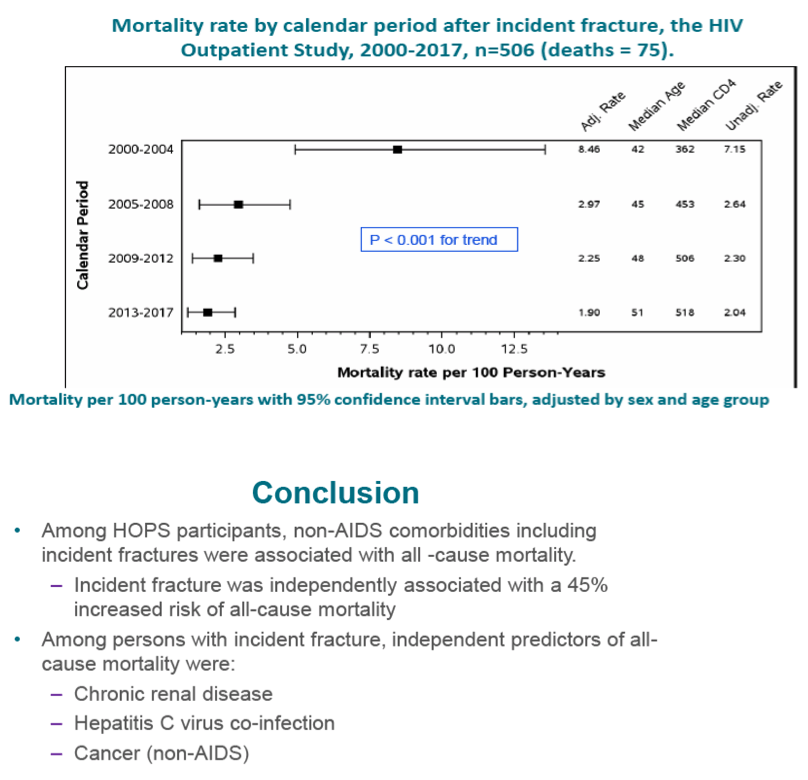
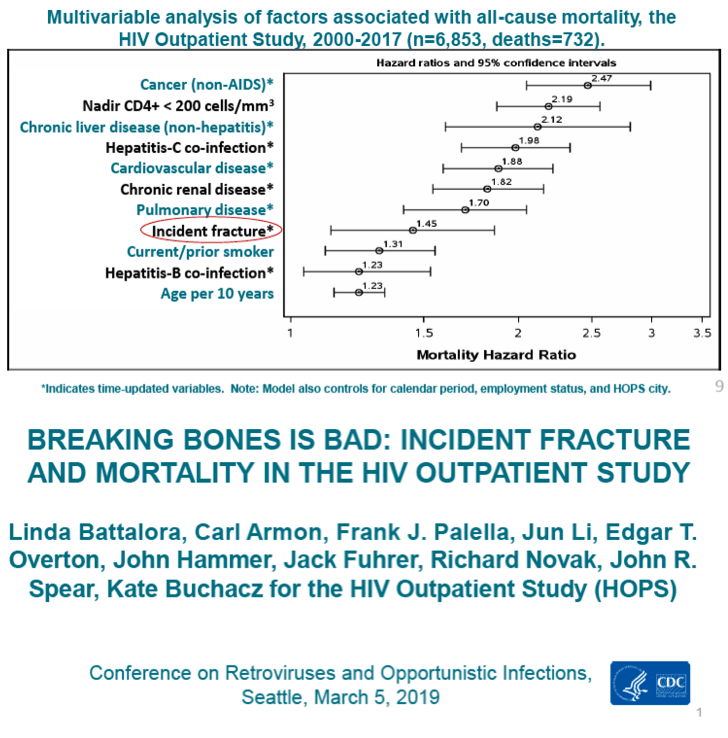
ABSTRACT
BREAKING BONES IS BAD: INCIDENT FRACTURE AND MORTALITY IN THE
HIV OUTPATIENT STUDY
Linda Battalora1, Carl Armon2, Frank J. Palella3, Jun Li4, Edgar T. Overton5, John Hammer6, Jack Fuhrer7, Richard Novak8, John Spear1, Kate Buchacz4
1Colorado School of Mines, Golden, CO, USA, 2Cerner Corp, Kansas City, MO, USA, 3Northwestern University, Chicago, IL, USA, 4CDC, Atlanta, GA, USA, 5University of Alabama at Birmingham, Birmingham, AL, USA, 6Denver Infectious Disease Consultants, Denver, CO, USA, 7Stony Brook University, Stony Brook, NY, USA, 8University of Illinois at Chicago, Chicago, IL, USA
Background: Persons living with HIV (PLWH) have higher rates of low bone mineral density (BMD) and fracture than those without HIV infection, but the contribution of bone fractures to mortality among aging PLWH in care in the United States (U.S.) has not been explored. We evaluated the associations of bone fracture with mortality controlling for sociodemographic, behavioral, and clinical factors.
Methods: We analyzed data from HIV Outpatient Study (HOPS) participants seen at nine U.S. HIV clinics from January 1, 2000 to September 30, 2017, with ≥2 HOPS encounters. Incident fracture rates and mortality after fracture were compared, adjusted by age, sex, and calendar period: 2000-2004, 2005-2008, 2009-2012, and 2013-2017. We used Cox proportional hazards analyses to determine factors associated with all-cause mortality for all participants and for the subset with incident fracture.
Results: Among 6,826 HOPS participants followed for a median of 6.2 years, 502 (7%) had incident fracture recorded and 729 (10%) had died. Of 502 fractures, 97 were major osteoporotic (hip, wrist, spine, shoulder) and 405 were not (47 site unknown). Median age at fracture was 48 years (interquartile range 41-55 years). Of patients, 16.5% with major osteoporotic fractures died (crude mortality 1.5 per 100 person-years [py]), while 14.6% with fractures at other sites died (crude mortality 1.3 per 100 py). Age- and sex-adjusted fracture rates per 100 py increased from 0.9 during 2000-2004 to 1.2 during 2013-2017 (p=0.037 for trend), and all-cause mortality rates per 100 py among those with incident fracture decreased from 8.5 to 1.9 (p=0.001 for trend), (Figure 1a and 1b, respectively). In multivariable analysis, incident fracture was significantly associated with all-cause mortality (Hazard Ratio 1.5, 95% confidence interval 1.2-1.9) as were multiple other factors, notably nadir CD4+ cell count < 200 cells/mm3, non-AIDS cancer, hepatitis C infection, and chronic liver, renal, and cardiovascular disease comorbidity.
Among the 502 patients followed after incident fracture, chronic renal disease and hepatitis C infection remained independently associated with all-cause mortality.
Conclusion: Incident fracture increased the risk of all-cause mortality by 50 percent among U.S. PLWH in care, underscoring the need for BMD screening and fracture prevention among at-risk patients. Although fracture rates among PLWH increased during follow-up, death rates after fracture decreased, coincident with advances in HIV care.
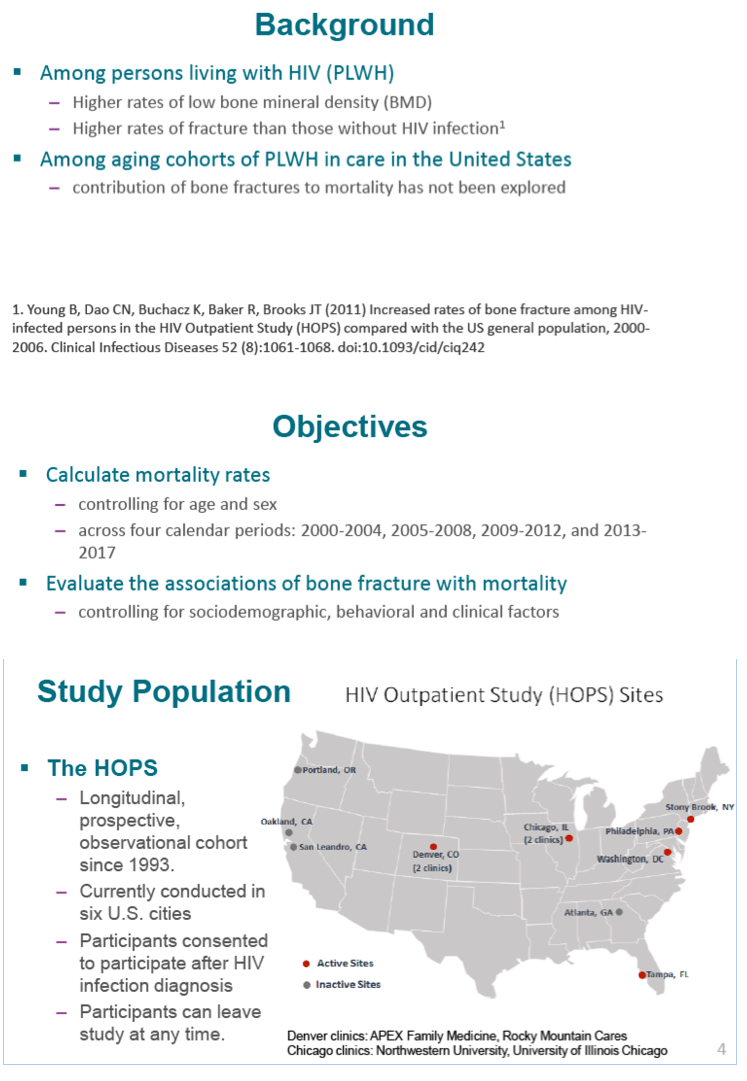
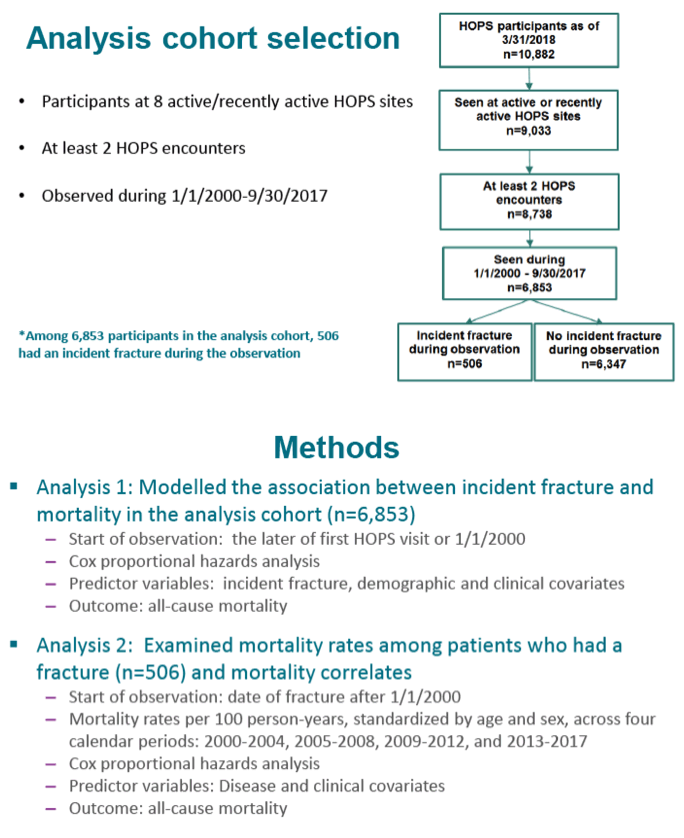
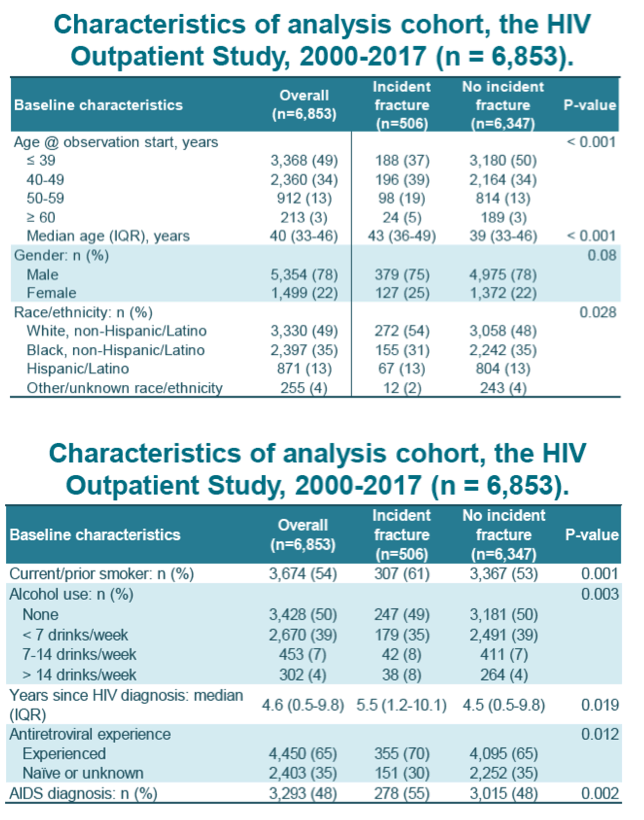
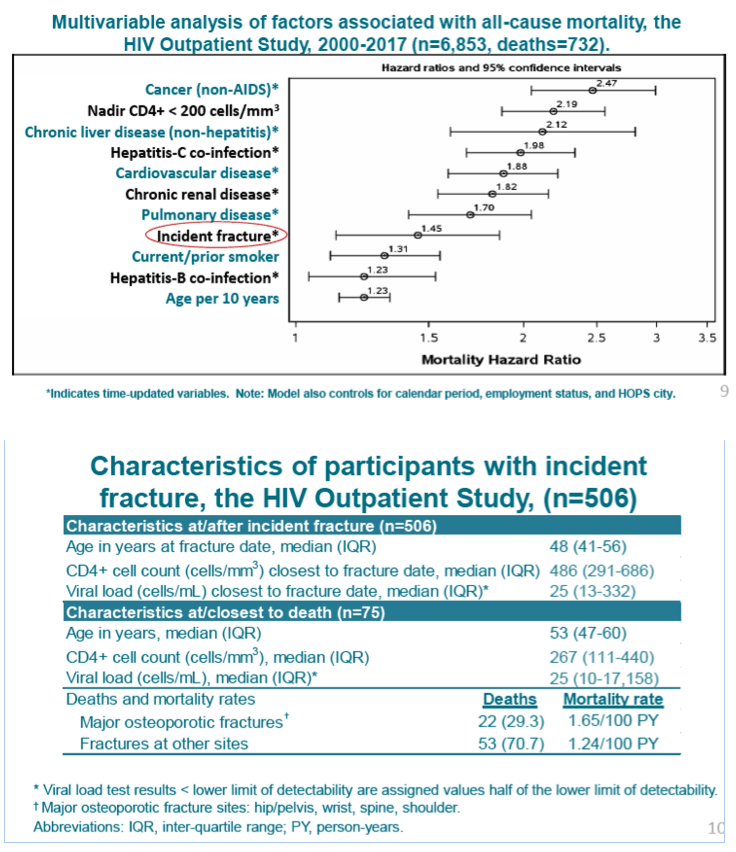
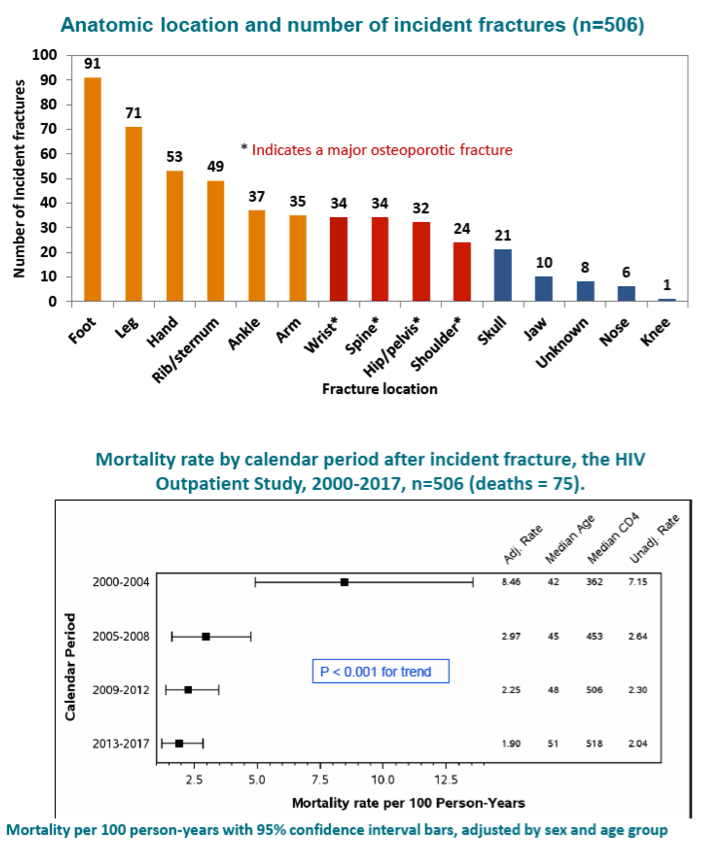
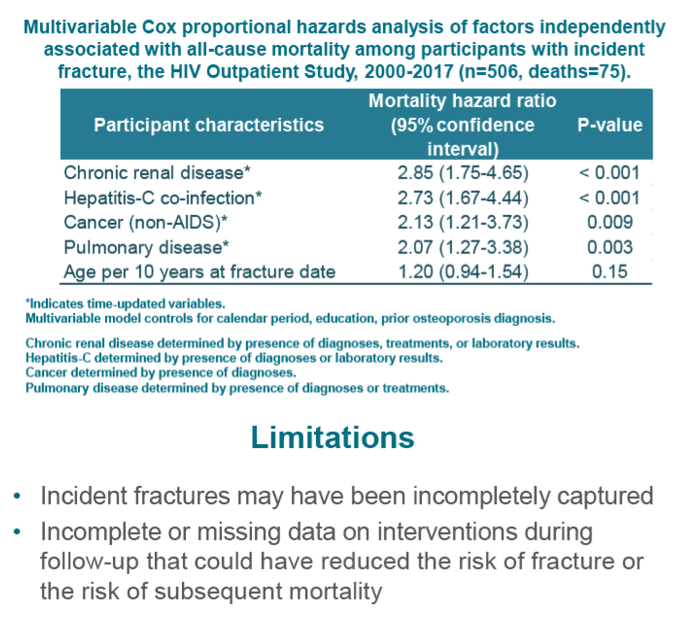
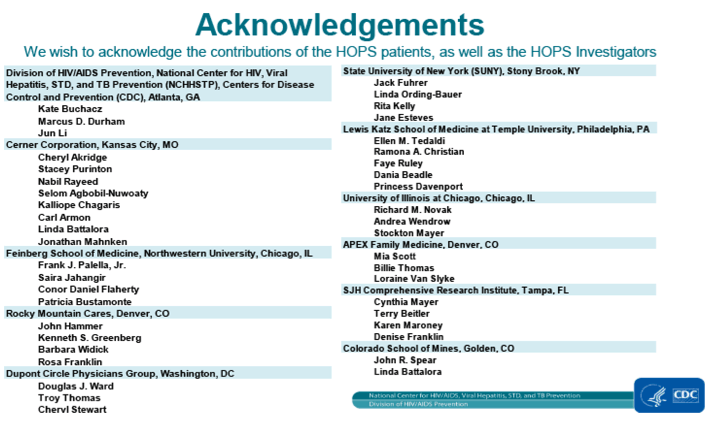
|
| |
|
 |
 |
|
|